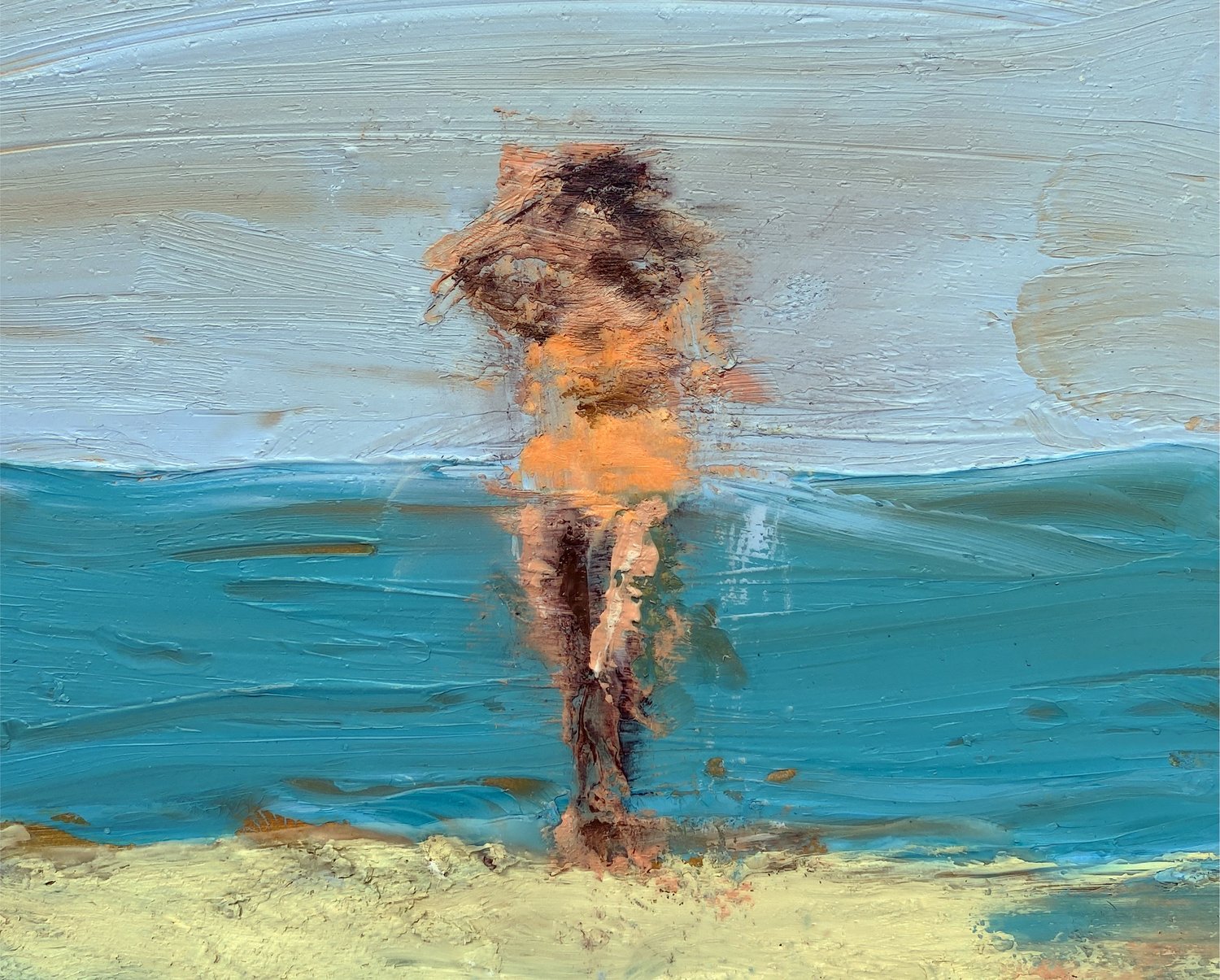‘Figure on a Beach’, oil and encaustic medium on wood, 10 x 13 cm (4 x 5 inch).
David Storey was born in the mining town of Workington, Cumbria, growing up on the coastal plain between the Irish Sea and the English Lake District – a bleak area of dark sandstone architecture and heavy rainfall.
His paintings explore a twilight zone of memory. Canvases peopled by blurred figures rescued from the past, staring back at the viewer like so many statues of antiquity, contemplating eternity.
Much of his darker toned work is tenebristic in style, contrasting the dominant sombre palette with flashes of light to great dramatic effect.
It has been said that art is the moment between a question and the answer, and this is where we find David’s paintings.
Matthew Hall
………………….
David Storey’s psychologically charged paintings explore a shifting world of half-remembered characters, forgotten places and lost moments. Playing with our appreciation of time, the scenes he represents resonate with our memories of experiences such as childhood holidays – of days on the lake or down by the beach – yet the characters who occupy them could as easily belong to the generations that have come before us. In part, the paintings might make us hanker back to some perfect day or better time, but these are not studies in nostalgia, there is also a darker edge here: a sense of something gathering overhead or an unexpected turn in circumstances waiting to enter from off-stage. Here too is a lingering melancholy, a sadness that merges with the still, calming quality of much of the work.
Brought to life from complex layers of paint, that Storey often manipulates with fingers, sponges and rags, the artist’s work has an uncanny ability to mould counterpoints into a single image, such that happiness and sadness can co-exist in the same space, or a moment of quiet reflection might be wrapped in a wider context of turmoil. Likewise, while the paintings are powerful, psychologically-charged pieces whose colours, contours and textures appear to brood with a deeply personal meaning, there remains a domestic commonality that enables us to share in the emotions they evoke. The juxtaposition of opposites is similarly apparent in the way Storey works, with an initial idea perhaps developing over years through sketches and draws, whereas the finished painting itself will be completed in hours or days.
The final burst that comes as Storey executes a painting is something he has clearly honed to a fine art, achieving an economy of content and composition that emphasises the emotional aura of the work. This expressionistic approach sees backgrounds that cross into abstraction provide ballast to the figurative centre ground. Working in this way, Storey is able to channel a diverse range of artists from Walter Sickert and Frank Auerbach to the more purely abstract work of Mark Rothko, whilst still being influenced by old masters such as Rembrandt and Caravaggio. In a contemporary context, Storey’s paintings therefore sit well in a climate of renewed appreciation for the technical and artistic skill required to produce figurative work, but where the 20th century developments in abstraction and representation remain equally relevant.
Having grown up in West Cumbria, a landscape he describes as ‘a bleak coastal plain welded onto the side of the Lake District’, and now living in Brighton, the influence of the sea brings its own weight to bear on his art. The dramatic possibility of changes in light and weather on the coast, of sunsets breaking through across the rain-soaked Irish Sea, and the expansive plain of sea and sky, have been harnessed in much of his work: whether overtly in a very conscious way, or more subtly in the simple contrast of light and shade. A sensation similar to the way in which standing on the coast can make us feel small or isolated is also something that recurs in many paintings, the composition focused on solitary moments that might quickly slip back into the ether that envelops them. It is here, on the edge of passing between being and unbeing, in the hope of preserving something that cannot truly be frozen in this way, that Storey’s world seems to hover. The fact that the faces of his characters are ofen blurred, as though caught in a passing glance, reminds us that these images are, or were, part of a moving world. With that comes the knowledge that we cannot go back to these moments, irrevocably severed from them as we are by the flow of time. And yet, perhaps…
Richard Unwin
Enquiries.
Join my Mailing List.
…………………………………………………………………….
Click to watch interview.
…………………………………………………………………….
